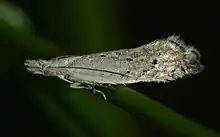Glyphipterix achlyoessa
Glyphipterix achlyoessa, commonly known as the cocksfoot stem borer, is a species of moth in the family Glyphipterigidae.[3] It is endemic to New Zealand.[1][2]
| Glyphipterix achlyoessa | |
|---|---|
 | |
| Scientific classification | |
| Kingdom: | Animalia |
| Phylum: | Arthropoda |
| Class: | Insecta |
| Order: | Lepidoptera |
| Family: | Glyphipterigidae |
| Genus: | Glyphipterix |
| Species: | G. achlyoessa |
| Binomial name | |
| Glyphipterix achlyoessa | |
| Synonyms[2] | |
| |
Taxonomy
This species was first described by Edward Meyrick in 1880 and named Phryganostola achlyoessa.[4][2] Meyrick used material he collected at the Wellington Botanic Garden at dusk in January.[2][4] George Hudson discussed and illustrated this species under the name Glyphipterix achlyoessa in 1928.[5]
The holotype specimen is held at the Natural History Museum, London.[2]
Description
Meyrick described the species as follows:
Head and thorax whitish-grey. Palpi whitish-grey, mixed with dark fuscous, second joint beneath with a long loose prejecting fringe of hairs. Antennae dark fuscous. Abdomen elongate, dark fuscous. Legs pale ochreous-grey. Fore-wings elongate, narrow, hind-margin strongly sinuate below apex; pale whitish-grey, faintly strigulated transversely with darker; a few solitary black scales, tending to be arranged longitudinally on fold and lower median vein ; cilia whitish, with an obscure dark fuscous apical hook, basal f separated by a blackish line and dark smoky-grey. Hind-wings and cilia fuscous-grey.[4]
Distribution
This moth is endemic to New Zealand and found throughout the country.[5][6] It is regarded as being common.[5]
Lifecycle and behaviour
This species is on the wing from October to December.[7] When disturbed it is likely to fly a short distance before landing on a grass stem.[5]
Habitat and host plant
This species prefers to inhabit meadows and grassy open spaces.[5] It appears to prefer introduced grass species.[5] A host plant for this species is Dactylis glomerata.[8][9] Larvae have also been found boring into Juncus species.[7]
References
| Wikispecies has information related to Glyphipterix achlyoessa. |
| Wikimedia Commons has media related to Glyphipterix achlyoessa. |
- "Glyphipterix achlyoessa (Meyrick, 1880)". www.nzor.org.nz. Landcare Research New Zealand Ltd. Retrieved 2018-07-11.
- Dugdale, J. S. (1988). "Lepidoptera-annotated catalogue, and keys to family-group taxa" (PDF). Fauna of New Zealand. 14: 1–264 – via Landcare Research New Zealand Ltd.
- "Cocksfoot stem borer (Glyphipterix achlyoessa)". iNaturalist.org. Retrieved 2019-04-06.
- Meyrick, Edward (1880). "Description of Australian Micro-Lepidoptera". Proceedings of the Linnean Society of New South Wales. 5: 204–271. doi:10.5962/bhl.part.15879. Retrieved 11 July 2018 – via Biodiversity Heritage Library.
- Hudson, G. V. (1928). The Butterflies and Moths of New Zealand. Wellington: Ferguson & Osborn Ltd. p. 312. OCLC 25449322.
- Gordon, Dennis P., ed. (2010). New Zealand Inventory of Biodiversity. Volume Two. Kingdom Animalia: Chaetognatha, Ecdysozoa, Ichnofossils. Vol. 2. Christchurch, N.Z.: Canterbury University Press. p. 460. ISBN 9781877257933. OCLC 973607714.
- Patrick, B.H. (1991). Insects of the Dansey ecological district (PDF). Wellington, N.Z.: Department of Conservation, New Zealand. p. 14. ISBN 0-478-01285-3. Retrieved 6 April 2019.
- "Glyphipterix achlyoessa Meyrick, 1880 Herbivore report". plant-synz.landcareresearch.co.nz. Retrieved 2019-04-06.
- Penman, D. R. (January 1978). "Biology of Euciodes suturalis (Coleoptera: Anthribidae) Infesting Cocksfoot in Canterbury". New Zealand Entomologist. 6 (4): 421–425. doi:10.1080/00779962.1978.9722309. ISSN 0077-9962 – via Taylor & Francis Online.